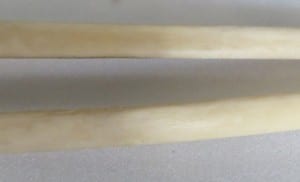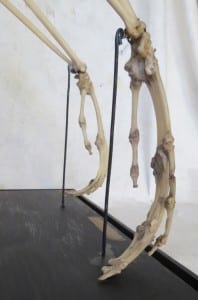Specimen of the Week: Week 175
By Tannis Davidson, on 18 February 2015
 Less than two weeks ago, the first batch of newly-conserved skeletons from our Bone Idols project returned to the Grant Museum after their completed restoration work.
Less than two weeks ago, the first batch of newly-conserved skeletons from our Bone Idols project returned to the Grant Museum after their completed restoration work.
Reg the Rhino -the largest skeleton in the Museum – was treated in this group and has now been remounted in fine form back on his plinth.
Homecoming celebrations continued with the unpacking of several smaller primate skeletons such as the juvenile orang-utan, one of the chimpanzees, and this week’s Specimen of the Week…
**The Lar Gibbon**
1. Haven’t we met before?
The keen-eyed among you may have spotted that this gibbon has been previously highlighted in our SOTW blog. Following its conservation and remounting by conservator Nigel Larkin it has been given a new lease on life and – like the most fabulous of make-overs -surely warrants its grand reveal.
2. 100 years younger
This specimen was quite dirty having accumulated dust and other particulate pollutants as a result of being on open display for decades. It first required dry cleaning to dislodge dust and debris (soft brush and gauze-covered hoover nozzle) followed by wet cleaning with a mild detergent solution using cotton bud swabs. This was followed by a final swab clean using cotton buds dipped in distilled water to remove any remaining detergent film.
Water soaked bone may crack when it dries so during this work, the skeleton was kept as dry as possible by cleaning small areas at a time and frequently patting the bones dry with small lint-free paper towels.
Besides the immediate improvement in appearance of the bones, cleaning the specimen serves to halt ongoing deterioration caused by dust and airborne pollutants that can abrade surfaces and lead to material disintegration.
3. The leg bone attaches to the … hip bone
Following the clean, the gibbon then required some restructuring. Prior to the conservation work, the forelimbs of the gibbon had no support and hung over the front edge of its plinth. This was rectified by re-positioning the main upright rod supporting the skeleton and adding extra support for the forelimbs and pectoral girdle by placing additional upright rods securely beneath both wrists. The right hand was also hanging off at the wrist and had to be re-glued into position as did the thumb of the right hand.
The heads of the femurs also needed to be adjusted to sit in the correct anatomical position, and the scapulae needed to be repositioned correctly. The scapulae are now tied on with thin polypropylene thread, and the feet are tied to the nails in the plinth with thin polypropylene thread as well. Furthermore, one digit on each foot was misplaced and needed adjustment and the loose cartilage of the lower left rib was adhered into place.
4. Next up
As part of the ongoing Bone Idols project, a further five specimens have now left the Museum to be treated: the quagga, crucifix fish, seal, and python mounted skeletons as well as a taxidermy turtle. Like the gibbon, these specimens are all in urgent need of conservation to ensure their long-term future as well as to continue to use them in teaching, research and public engagement. These specimens will return in April – so please stay tuned to follow their progress and reinstallations.
We would be extremely grateful for any support you can give the Bone Idols Project. Find out how you can contribute to this important work by visiting our online giving page.
Tannis Davidson is Curatorial Assistant at the Grant Museum of Zoology
 Close
Close





